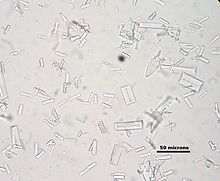Crystalluria
Appearance
| Crystalluria | |
|---|---|
 | |
| Struvite crystals found in a urinalysis |
Crystalluria refers to crystals found in the urine when performing a urine test. Crystalluria is considered often as a benign condition and as one of the side effects of sulfonamides and penicillins.
The main reason for the identification of urinary crystals is to detect the presence of the relatively few abnormal types that may represent a disease.
Clinical significance
It can be an indication of urolithiasis.
It may be relevant when there is presence of specific abnormal types of crystals (cystine, cholesterol, leucine, tyrosine, etc.)[1] and that may be a sign of metabolic or liver disorders such as cystinuria.[2] It leads to formation of stones.
References
- ^ MrlabTest - Crystals in urine, Crystalluria. URL: https://www.mrlabtest.com/urinalysis/crystals-urine.htm. Accessed on: December 10, 2021.
- ^ Daudon M, Cohen-Solal F, Barbey F, Gagnadoux MF, Knebelmann B, Jungers P (July 2003). "Cystine crystal volume determination: a useful tool in the management of cystinuric patients". Urol. Res. 31 (3): 207–11. doi:10.1007/s00240-003-0319-0. PMID 12748836.
External links
